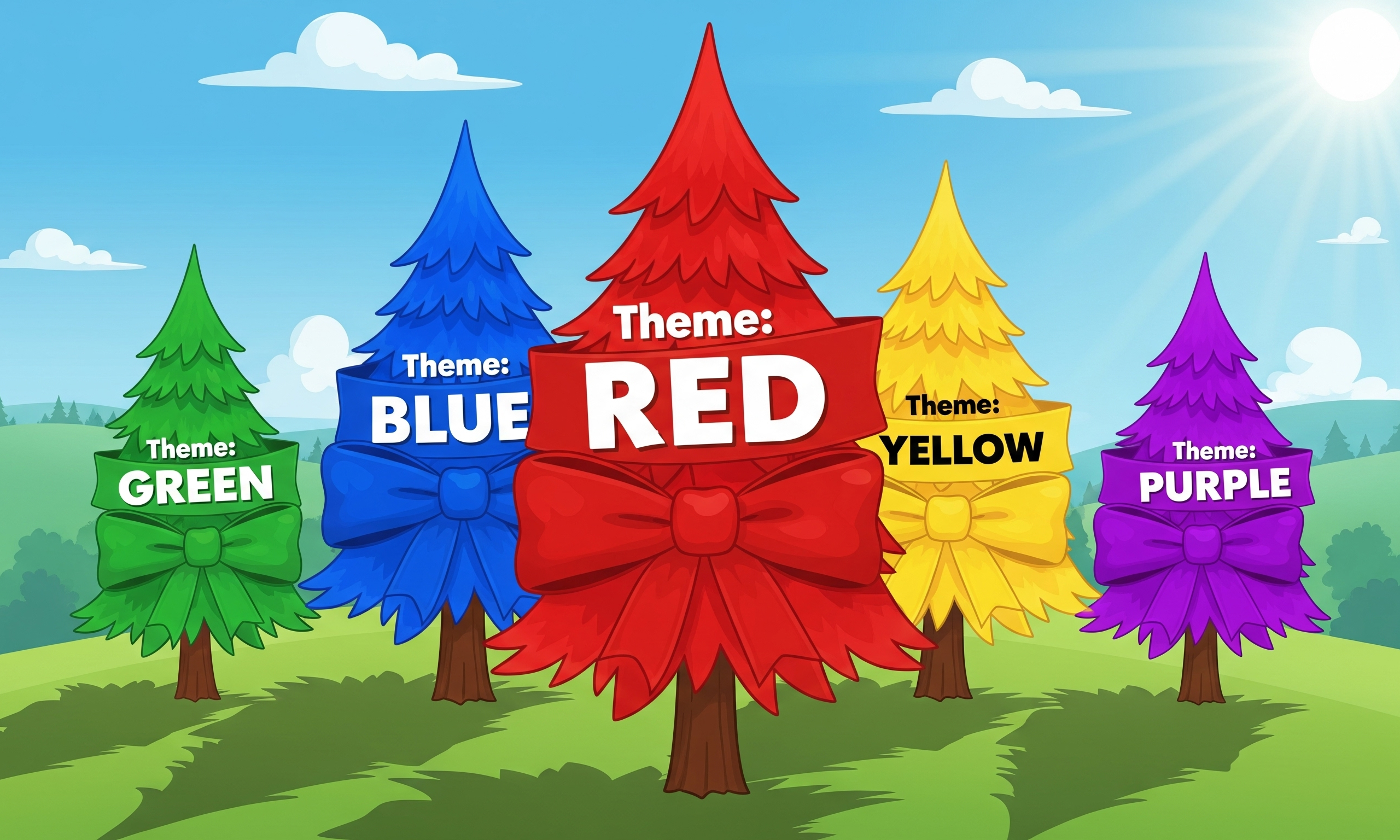Configurable and Themeable
We're excited to announce version 2.0.0 of @allxsmith/bestax-bulma, bringing powerful new configuration and theming capabilities that fully embrace Bulma v1's modern approach to CSS customization.
This release introduces two major features that transform how you can customize and integrate Bulma components: ConfigProvider for global component configuration (including CSS class prefixing), and Theme for comprehensive CSS variable-based theming.

With ConfigProvider, you can now globally configure all bestax-bulma components using the useConfig hook, enabling seamless integration with other CSS frameworks through class prefixing. The new Theme component allows you to customize Bulma's appearance using CSS variables at both global and scoped nested levels, giving you unprecedented control over your design system.
We need to address an important note about versioning: we accidentally bumped this release to 2.0.0 instead of the intended 1.2.0. This became a major release due to a semantic-release configuration issue, when it should have been a minor release.
However, all changes are completely backward compatible - version 2.x.x is fully compatible with 1.x.x. We decided it's easier to move forward with the new version number rather than create confusion with republishing.
ConfigProvider: Global Component Configuration
The new ConfigProvider component addresses a critical need in modern web development: the ability to namespace CSS classes to avoid conflicts. This becomes especially important with Bulma v1's enhanced support for prefixed CSS classes.
While not ideal, you can use prefixed css classes when integrating multiple CSS frameworks. Prefixed css classes help avoid class name collisions.
Why We Need ConfigProvider
When building applications, you may want to prefix your Bulma CSS classes with a custom namespace like "bulma-" or your own brand name. This provides better control over your CSS architecture and helps organize your styles. Bulma v1 recognized this need and now supports CSS class prefixing out of the box. While prefixing can also help in non-ideal situations where you need to integrate with other CSS frameworks like Bootstrap or Tailwind CSS, the primary benefit is having organized, namespaced CSS that follows your project's conventions.
The ConfigProvider enables you to:
- Prefix all Bulma CSS classes with a custom namespace (e.g.,
bulma-) - Integrate seamlessly with other CSS frameworks
- Support custom Bulma builds with your own prefixes
- Maintain consistent configuration across your entire component tree
Supporting Prefixed Bulma CSS
If you're using the official prefixed Bulma CSS file (bulma-prefixed.min.css), you can now use it seamlessly:
import { ConfigProvider, Box, Title, Button } from '@allxsmith/bestax-bulma';
import 'bulma/css/versions/bulma-prefixed.min.css';
function App() {
return (
<ConfigProvider classPrefix="bulma-">
<Box>
<Title>Prefixed Bulma Components</Title>
<Button color="primary">This uses bulma-button class</Button>
</Box>
</ConfigProvider>
);
}
This renders the following HTML with prefixed CSS classes:
<div class="bulma-box">
<h1 class="bulma-title">Prefixed Bulma Components</h1>
<p>
All components inside this ConfigProvider will have their CSS classes
prefixed with "bulma-". This allows you to use Bulma alongside other CSS
frameworks without class name conflicts.
</p>
<button class="bulma-button bulma-is-primary">
This uses bulma-button class
</button>
</div>
Custom Prefix Support
For teams building their own Bulma CSS with custom prefixes, you can configure your SASS build and use the same prefix in ConfigProvider:
Setup Bulma and SASS
npm install bulma sass
Create this custom Sass file
// In your SASS build
@use 'bulma/sass' with (
$class-prefix: 'mycompany-'
);
Finally, import the custom Sass file into your react entry point
import { ConfigProvider, Box, Title, Button } from '@allxsmith/bestax-bulma';
import './styles/mycompany-bulma.scss';
function App() {
return (
<ConfigProvider classPrefix="mycompany-">
<Box>
<Title>Prefixed Bulma Components</Title>
<Button color="primary">This uses bulma-button class</Button>
</Box>
</ConfigProvider>
);
}
Two CSS Frameworks Example
Here's a comprehensive example showing ConfigProvider in action with the less ideal situation: two css frameworks coexisting together.
function FrameworkIntegration() {
return (
<div>
{/* Bootstrap section with equivalent markup */}
<div className="card p-4 mb-4">
<h4 className="card-title">Bootstrap Components</h4>
<p className="card-text">
This section uses Bootstrap classes for styling.
</p>
<button className="btn btn-info">Bootstrap Button</button>
</div>
{/* Prefixed Bulma components to avoid conflicts */}
<ConfigProvider classPrefix="bulma-">
<Box>
<Title size="4">Prefixed Components</Title>
<p>
All components inside this ConfigProvider will have their CSS
classes prefixed with "bulma-", preventing conflicts with other
frameworks.
</p>
<Button color="primary">Prefixed Bulma Button</Button>
</Box>
</ConfigProvider>
</div>
);
}
Theme Component: CSS Variable-Based Theming
The new Theme component leverages CSS custom properties (CSS variables) to provide dynamic, runtime theming capabilities that were previously only possible with SASS preprocessing. This approach offers significant advantages over traditional methods.

The Power of CSS Variables vs. SASS Variables
While SASS variables are compile-time constants, CSS variables are runtime values that can be:
- Changed dynamically with JavaScript
- Inherited through the CSS cascade
- Scoped to specific DOM elements
- Modified without rebuilding your CSS
This means you can create themes that respond to user preferences, time of day, or any other runtime condition:
These theme examples look best in dark mode. Switch to dark mode using the toggle in the top navigation for the optimal viewing experience.
function DynamicTheming() { const [isLunar, setIsLunar] = useState(false); const [signees, setSignees] = useState([ 'John Adams', 'Samuel Adams', 'Benjamin Franklin', ]); const theme = React.useMemo( () => ({ '--bulma-scheme-h': isLunar ? '260' : '220', // midnight: purple hue, sky: light blue hue '--bulma-scheme-s': isLunar ? '30%' : '90%', // midnight: muted saturation, sky: vibrant '--bulma-light-l': isLunar ? '8%' : '10%', // midnight: very dark, sky: very light '--bulma-dark-l': isLunar ? '85%' : '90%', // midnight: light text, sky: dark text }), [isLunar] ); const handleSubmit = e => { e.preventDefault(); const formData = new FormData(e.target); const name = formData.get('name'); if (name) { setSignees([...signees, name]); e.target.reset(); } }; return ( <Theme bulmaVars={theme} isRoot> <Button onClick={() => setIsLunar(!isLunar)} mb="4"> Toggle {isLunar ? 'Lunar' : 'Midnight'} Theme </Button> <Box> <Columns> <Column> <Content> <Title size="4">A Call to Action</Title> <p> <strong>Fellow Citizens,</strong> it is with great conviction that we present this petition to secure the blessings of liberty for ourselves and our posterity. As the immortal words of our founding documents declare, when a long train of abuses and usurpations evinces a design to reduce them under absolute despotism, it is their right, it is their duty, to throw off such government. </p> <p> The experience of ages has proven that mankind are more disposed to suffer, while evils are sufferable, than to right themselves by abolishing the forms to which they are accustomed. But when circumstances compel us to action, we must not hesitate to secure our fundamental rights. </p> <p> <em> Join your fellow citizens in this righteous cause. Add your name to this petition and let your voice be heard in the halls of justice. </em> <p> <cite>-- Alexander Hamilton</cite> </p> </p> </Content> </Column> <Column> <Box> <Title size="5">Sign the Petition</Title> <form onSubmit={handleSubmit}> <Field label="Full Name"> <Control> <Input name="name" placeholder="Enter your full name" required /> </Control> </Field> <Field label="State"> <Control> <Input name="state" placeholder="Your state of residence" /> </Control> </Field> <Field> <Control> <Button type="submit" color="primary"> Add My Signature </Button> </Control> </Field> </form> <Title size="6" mt="4"> Current Signatories </Title> <Content> <ul> {signees.map((name, index) => ( <li key={index}>{name}</li> ))} </ul> </Content> </Box> </Column> </Columns> </Box> </Theme> ); }
CSS Variables vs. Utility Classes
While utility classes like Tailwind CSS provide granular control, CSS variables offer superior theming capabilities:
- Semantic theming: Define color roles (primary, secondary) rather than specific colors
- Consistent relationships: Automatic hover/active states based on base colors
- Global consistency: Change one variable, update entire design system
- Performance: No class proliferation or CSS bloat
Tailwind CSS is a fantastic framework with CSS variable support built into it's core theming.
Tailwind CSS primarily encourages the use of utility classes over directly manipulating CSS variables for styling, as its core philosophy is "utility-first,"

Global and Scoped Theming
The Theme component supports both global theming (affecting your entire application) and scoped theming (affecting only specific sections):
Global Theme Example
These theme examples look best in dark mode. Switch to dark mode using the toggle in the top navigation for the optimal viewing experience.
function GlobalSunsetTheme() { const sunsetTheme = React.useMemo( () => ({ '--bulma-scheme-h': '18', // sunset orange hue '--bulma-scheme-s': '90%', '--bulma-primary-h': '25', '--bulma-primary-s': '85%', '--bulma-primary-l': '55%', }), [] ); function App() { return ( <Box> <Title size="3">Contact Us</Title> <Field label="Name"> <Control> <Input placeholder="Your full name" /> </Control> </Field> <Field label="Email"> <Control> <Input type="email" placeholder="[email protected]" /> </Control> </Field> <Field label="Message"> <Control> <Input placeholder="How can we help you?" /> </Control> </Field> <Field> <Control> <Button color="primary">Send Message</Button> </Control> </Field> </Box> ); } return ( <Theme bulmaVars={sunsetTheme}> <App /> {/* Entire app uses sunset theme */} </Theme> ); }
Scoped Theme Example
These theme examples look best in dark mode. Switch to dark mode using the toggle in the top navigation for the optimal viewing experience.
function ScopedTheming() { return ( <div> <Title>Standard Theme Header</Title> <Block> <Theme primaryH="120" primaryS="100%" primaryL="40%"> <Box> <Title size="4">Forest Green Section</Title> <Button color="primary">Green Button</Button> </Box> </Theme> </Block> <Block> <Theme primaryH="280" primaryS="100%" primaryL="45%"> <Box> <Title size="4">Purple Section</Title> <Button color="primary">Purple Button</Button> </Box> </Theme> </Block> </div> ); }
Advanced Theming with Complete Color Schemes
The Theme component supports all 500+ Bulma CSS variables, allowing for comprehensive design system customization:
These theme examples look best in dark mode. Switch to dark mode using the toggle in the top navigation for the optimal viewing experience.
function ForestTheme() { function CompleteApp() { return ( <Hero size="medium"> <Hero.Head> <Navbar> <Container> <Navbar.Brand> <Navbar.Item as="a"> <Title size="5">Forest Theme</Title> </Navbar.Item> </Navbar.Brand> <Navbar.Menu> <Navbar.End> <Navbar.Item as="a">Getting Started</Navbar.Item> <Navbar.Item as="a">Components</Navbar.Item> <Navbar.Item as="a">Themes</Navbar.Item> <Navbar.Item as="span"> <Button color="primary" isInverted> Download </Button> </Navbar.Item> </Navbar.End> </Navbar.Menu> </Container> </Navbar> </Hero.Head> <Hero.Body> <Container textAlign="centered"> <Title>Forest Green Design</Title> <SubTitle>Experience nature-inspired theming</SubTitle> <Button color="success" size="large"> Explore Components </Button> </Container> </Hero.Body> <Hero.Foot> <Container> <Content textAlign="centered"> <p> <strong>Forest Theme</strong> demonstrates comprehensive CSS variable theming. </p> </Content> </Container> </Hero.Foot> </Hero> ); } return ( <Theme schemeH="150" // forest green base schemeS="50%" lightL="80%" darkL="18%" primaryH="160" primaryS="60%" primaryL="45%" successH="120" warningH="45" dangerH="355" hoverBackgroundLDelta="4%" activeBackgroundLDelta="8%" isRoot > <CompleteApp /> </Theme> ); }
Combining ConfigProvider and Theme
The real power comes from combining both providers for maximum flexibility. Okay maybe not real power per se...
function EnterpriseApp() {
return (
<ConfigProvider classPrefix="mycompany-">
<Theme primaryH="210" primaryS="100%" primaryL="45%" isRoot>
<App />
</Theme>
</ConfigProvider>
);
}
Summary: Full Bulma v1 Support
With version 2.0.0, @allxsmith/bestax-bulma now fully supports the modern concepts introduced in Bulma v1, the latest version of Bulma in 2025. Our implementation provides:
- Complete CSS variable theming with 500+ supported variables
- Class prefix configuration for framework integration
- Runtime theme switching capabilities
- Scoped and global theming options
- TypeScript-first design with full type safety
We're committed to continuing our support for Bulma as it evolves, and you can expect new modular configuration options in future releases of this package.
The foundation we've built with ConfigProvider and Theme components will serve as the basis for even more powerful customization features to come.
Whether you're building a simple website or a complex enterprise application, @allxsmith/bestax-bulma now provides the tools you need to create consistent, themeable, and maintainable user interfaces that leverage the full power of modern CSS.
